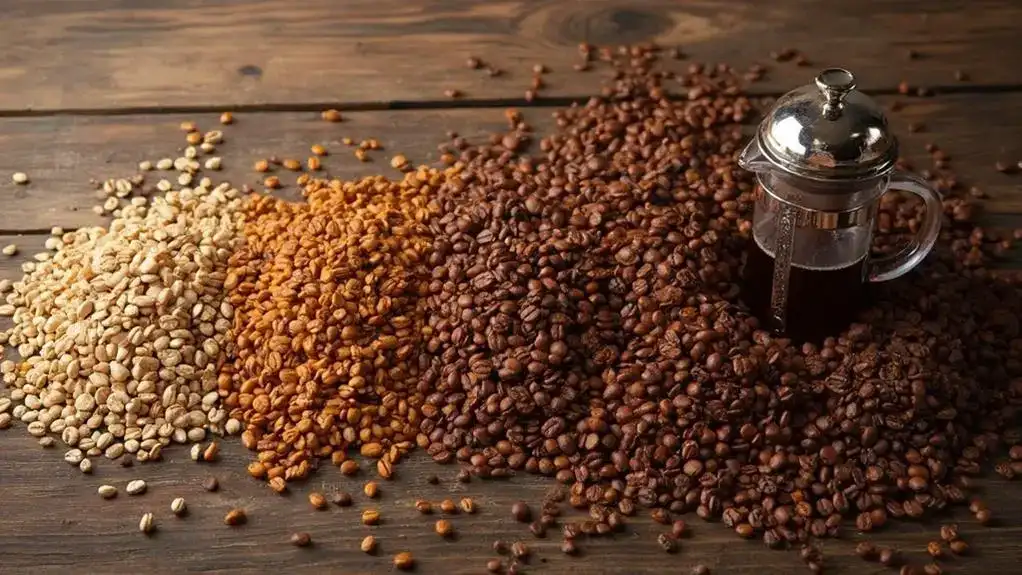The Coffee Intensity Scale is an essential tool that ranges from mild (1) to bold (13), designed to help you navigate the spectrum of coffee flavors and strengths. This scale simplifies your decision-making process, aligning coffee choices with personal taste preferences. Different brands interpret intensity ratings uniquely, with lower numbers indicating milder flavors and higher numbers signifying bolder profiles. Curiously, intensity doesn’t directly correlate with caffeine content; factors like roast levels and bean types play significant roles. By understanding this scale, you can explore diverse coffee options that suit your palate, leading you to discover even more about your favorite brews.
What is the Coffee Intensity Scale?

The coffee intensity scale serves as an essential tool for consumers, helping you navigate the diverse flavors and strengths of coffee.
By providing a clear range from mild to bold, it allows you to select brews that align with your taste preferences, whether you enjoy a light cup or a robust experience.
Understanding this scale not only enhances your coffee choices but also improves your overall enjoyment of the beverage.
Purpose of the Intensity Scale
The coffee intensity scale serves as a key measurement system that helps you understand the strength and flavor profile of various coffee options.
By using this scale, you can make informed choices based on your preferences, whether you like something light and smooth or bold and rich.
Here are some essential points to take into account:
- Ranges typically from 1 to 13, with lower numbers indicating milder flavors.
- Higher ratings signal bolder, more intense coffee experiences.
- Intensity doesn’t directly correlate with caffeine content.
- It simplifies the selection process for both casual drinkers and aficionados.
- Different brands may have unique interpretations of the scale.
Understanding the Measurement System
Often overlooked, the coffee intensity scale serves an essential purpose in guiding your coffee choices.
It categorizes flavors from mild to bold, enhancing your coffee tasting and flavor exploration.
By using this measurement system, you can pinpoint the perfect brew to suit your palate, ensuring a satisfying experience.
What Are the Scale Levels of Coffee Intensity?
The coffee intensity scale ranges from 1 to 13, allowing you to quickly assess the strength and flavor profile of different coffee options.
A rating of 1 indicates a very mild taste, while a rating of 13 signifies a bold and complex brew.
Understanding these levels helps you choose a coffee that perfectly aligns with your personal preferences, whether you enjoy lighter or richer flavors.
Range of Ratings
When exploring the coffee intensity scale, understanding how different brands rate their coffee can be key to making informed choices. Each brand may have its own method of rating intensity, which can lead to variations in flavor experience. Below is a comparison table showcasing ratings from popular coffee brands to help you navigate these differences effectively.
| Brand | Intensity Rating | Flavor Profile |
|---|---|---|
| Nespresso | 1 – 13 | Mild to Bold |
| Starbucks | 1 – 10 | Light to Dark |
| Peet’s | 1 – 5 | Smooth to Strong |
| Lavazza | 1 – 9 | Mild to Intense |
| Dunkin’ | 1 – 10 | Subtle to Robust |
Comparison of Different Brands
Many coffee brands utilize their own intensity scales, ranging typically from 1 to 13, to indicate the flavor strength and boldness of their products. This variety fosters brand comparisons and influences consumer preferences. Below is a simplified comparison of intensity levels:
| Brand | Intensity Level | Flavor Profile |
|---|---|---|
| Nespresso | 1-13 | Mild to Bold |
| Starbucks | 1-10 | Light to Dark |
| Peet’s | 1-5 | Smooth to Robust |
What Factors Influence Coffee Intensity?

When you’re selecting coffee, the type of beans used plays an essential role in determining its intensity.
Different varieties, such as Arabica and Robusta, offer distinct flavor profiles and strength levels; for instance, Robusta beans typically deliver a bolder taste and higher caffeine content.
Understanding these differences can greatly enhance your coffee experience, allowing you to choose blends that suit your preferences.
Types of Coffee Beans
When it comes to coffee intensity, two key factors stand out: roast levels and brewing methods. These elements greatly impact the flavor profile and overall strength of your coffee, making it essential to understand how they interact.
Here are some points to reflect on:
- Roast Levels: Lighter roasts tend to highlight acidity and sweetness, while darker roasts often bring out bitterness and deeper flavors.
- Brewing Methods: Different methods can extract varying intensities; for example, espresso typically results in a bolder flavor compared to drip brewing.
- Bean Types: Arabica beans generally offer milder flavors, while Robusta beans are known for their stronger, more bitter notes.
- Grind Size: Finer grinds can enhance extraction, leading to a more intense cup, while coarser grinds may produce a milder taste.
- Brewing Time: Longer brewing times can intensify flavors and bitterness, while shorter times might lead to a lighter, smoother cup.
Roast Levels
Roast levels play an essential role in determining coffee intensity, as they greatly impact the flavor profile and overall experience of the brew.
Different coffee roasts include:
- Light roast: bright and acidic
- Medium roast: balanced and smooth
- Medium-dark roast: rich and complex
- Dark roast: bold and slightly bitter
- Espresso roast: concentrated and intense
Each level offers unique characteristics, shaping your coffee journey.
Brewing Methods
The choice of brewing method greatly influences the intensity and flavor profile of your coffee. Key factors to take into account include:
- Brewing equipment
- Brew time
- Coffee grind
- Water temperature
- Extraction method
Each aspect affects brew strength and flavor balance, impacting coffee freshness and serving size.
Understanding these elements helps you refine brew ratios and elevate your coffee experience, ensuring a satisfying cup tailored to your preferences.
How Does Caffeine Content Relate to Coffee Intensity?
When you choose coffee, it’s easy to assume that higher caffeine content means stronger flavor, but that’s not always the case.
Notably, a coffee pod rated low on the intensity scale can have the same caffeine level as one rated much higher.
This discrepancy arises because flavor intensity is influenced more by factors like roast level and bean type than by caffeine itself, making it essential to understand how these elements interact.
Relationship Between Flavor and Caffeine
Many people mistakenly believe that a coffee’s intensity directly correlates with its caffeine content.
In reality, the intensity scale primarily measures flavor strength, while caffeine levels can vary independently across different roasts.
For instance, a light roast rated low on the intensity scale can sometimes contain more caffeine than a darker roast with a higher intensity rating, highlighting the complexity of flavor and caffeine relationships in coffee.
Misconceptions About Strength
Understanding how caffeine content relates to coffee intensity can clear up common misconceptions about strength.
Many believe that higher intensity equates to more caffeine, but that’s not always true. Misconceptions clarified reveal that flavor richness often overshadows caffeine levels.
Intensity explained shows that factors like roast and bean type play essential roles, allowing you to confidently choose coffee that aligns with your taste preferences.
What Taste Profiles Are Associated with Different Intensities?

When you explore low-intensity coffees, typically rated between 1 and 3, you’ll find they offer light and smooth flavor profiles.
These coffees often highlight sweeter and more acidic notes, making them ideal for those who prefer a gentler experience.
Understanding these taste characteristics helps you choose a coffee that aligns with your specific preferences.
Low-Intensity Coffees
When you explore low-intensity coffees, you’re in for a treat of subtle flavors and gentle aromas.
These coffees, typically rated between 1 and 3, offer a revitalizing experience that can be quite different from their more robust counterparts.
Here are some taste profiles you might encounter:
- Light body
- Sweet notes
- Floral undertones
- Mild acidity
- Smooth finish
Understanding these characteristics can help you appreciate the nuances before moving on to medium and high-intensity coffees.
Medium-Intensity Coffees
Medium-intensity coffees, typically rated between 4 and 6 on the intensity scale, offer a balanced flavor profile that appeals to many coffee drinkers.
You’ll find medium roasts that present an enticing mix of taste notes. Consider these attributes:
- Mild sweetness
- Light acidity
- Subtle bitterness
- Nutty undertones
- Fruity hints
This balance allows for versatile pairings, enhancing your coffee experience while showcasing unique flavor combinations.
High-Intensity Coffees
High-intensity coffees, typically rated between 7 and 10 on the intensity scale, are known for their bold and robust flavor profiles.
These bold coffees often feature:
- Pronounced bitterness
- Rich, dark chocolate notes
- Strong aromas
- Full-bodied consistency
- Complex aftertastes
You’ll discover that high intensity flavors create an exhilarating experience, perfect for those seeking an innovative coffee journey.
How Can Consumers Use the Intensity Scale for Selection?
When choosing coffee, you can use the intensity scale as a valuable guide to match your flavor preferences.
By checking the rating on the packaging, you’ll quickly identify whether a coffee pod offers a mild, balanced, or bold experience.
This understanding not only simplifies your selection process but also enhances your overall enjoyment by aligning your choice with your desired taste profile.
Using the Intensity Scale for Choices
When you’re selecting coffee pods, understanding packaging labels is essential for making informed choices.
The intensity scale on the packaging directly indicates the flavor profile, helping you quickly assess whether the coffee is mild or bold.
Understanding Packaging Labels
Understanding the intensity scale on coffee packaging can greatly enhance your selection process.
By focusing on packaging design and label clarity, you can quickly identify the strength and flavor profile of various coffee options.
This knowledge empowers you to choose a coffee that aligns with your taste preferences, ensuring a satisfying experience.
A clear intensity rating simplifies your decision-making, making coffee exploration more innovative.
How Do Brewing Techniques Impact Coffee Intensity?

Brewing techniques considerably affect coffee intensity, influencing both flavor and strength.
For instance, espresso, brewed under high pressure, extracts bold flavors and higher concentrations of oils, resulting in a rich and intense cup.
In contrast, drip coffee, which relies on gravity and longer brewing times, typically yields a smoother but milder flavor profile, showcasing how the method can alter your coffee experience.
Espresso vs. Drip Coffee
When you’re choosing between espresso and drip coffee, the brewing method plays an essential role in determining coffee intensity. Each technique extracts flavors differently, impacting both strength and overall experience. Here’s how they compare:
- Extraction Time: Espresso uses high pressure and short brewing time for intense flavor, while drip coffee brews slowly, extracting different taste notes.
- Coffee-to-Water Ratio: Espresso has a higher coffee-to-water ratio, leading to a more concentrated flavor compared to the lighter profile of drip coffee.
- Grind Size: Espresso requires a fine grind for ideal extraction, whereas drip coffee uses a coarser grind to prevent over-extraction.
- Brew Temperature: Higher temperatures in espresso brewing enhance flavor extraction, while drip coffee typically brews at lower temperatures for a milder taste.
- Flavor Complexity: Espresso often features bold, rich flavors, while drip coffee can showcase a wider range of subtle notes due to its longer brewing process.
Understanding these differences can help you adjust your brewing methods to achieve your desired coffee intensity.
Adjusting Brew Methods for Desired Intensity
Choosing the right brewing method can greatly alter the intensity of your coffee, with espresso and drip coffee showcasing two distinct approaches.
Consider these aspects:
- Brew strength varies considerably between methods.
- Espresso offers concentrated flavor extraction.
- Drip coffee provides a milder profile.
- Adjust grind size for desired intensity.
- Water temperature influences extraction efficiency.
Understanding these differences enhances your coffee experience and helps you achieve your preferred flavor intensity.
How Do Personal Preferences Shape Coffee Intensity Perception?
Your personal preferences play a significant role in how you perceive coffee intensity, as taste is inherently subjective.
What one person finds bold and robust might seem overwhelming to another. This subjectivity influences not only your choice of coffee but also your overall experience, making it essential to explore different intensities to discover what truly resonates with your palate.
Subjectivity of Intensity
When you experiment with different coffee flavors, you discover how personal preferences greatly shape your perception of intensity.
Each individual’s taste can influence whether a coffee rated as bold feels overwhelming or just right.
This subjective experience highlights the importance of trying various intensities to find what truly resonates with your palate.
Experimenting with Different Flavors
Exploring different flavors in coffee can greatly shape how you perceive its intensity.
By experimenting with various flavor combinations, you can enhance your tasting experiences.
Personal preferences play a vital role; what one person finds bold, another may consider mild.
This subjectivity reveals that tasting coffee isn’t just about intensity but also about discovering unique flavors that resonate with your palate.
What Are the Cultural and Regional Variations in Coffee Intensity?

When exploring coffee intensity, you’ll notice significant cultural and regional preferences that shape what people enjoy.
For instance, Italians often favor espresso with a bold intensity, while Scandinavian countries lean towards lighter brews with subtle flavors.
These variations reflect not only local tastes but also the historical and social contexts that influence coffee consumption worldwide.
Global Preferences for Coffee Intensity
When exploring global preferences for coffee intensity, you’ll notice that cultural and regional factors play a significant role in shaping choices.
Different areas have unique traditions and tastes that influence how people enjoy their coffee, leading to varied intensity preferences. Here are some key points to reflect on:
- European Countries: Often favor strong, espresso-based drinks with high intensity ratings.
- North America: Leans towards medium roasts, balancing strength with smoother flavor profiles.
- Latin America: Typically enjoys lighter brews, emphasizing sweetness and acidity over boldness.
- Asia: Presents diverse preferences, from strong coffee in some regions to lighter, more delicate flavors in others.
- Middle East: Frequently opts for intensely spiced coffee, showcasing rich flavors and full-bodied experiences.
Understanding these variations can enhance your appreciation of coffee and help you choose blends that align with your preferences.
Impact of Culture on Coffee Choices
Coffee lovers around the world have diverse preferences shaped by their cultural backgrounds and regional traditions.
Cultural influences dictate flavor traditions, where coffee rituals vary considerably. For instance, brewing customs in Italy emphasize intensity through espresso, while Scandinavian countries favor lighter brews.
These regional preferences reflect unique taste heritages and social settings, ultimately influencing drinking habits and creating a rich tapestry of global coffee intensity experiences.
Conclusion
Understanding the coffee intensity scale enhances your coffee experience by helping you choose brews that match your taste. Curiously, studies show that nearly 70% of coffee drinkers prefer medium to dark roasts, indicating a strong inclination toward bolder flavors. By recognizing the factors that influence intensity, such as bean type and roast level, you can refine your selection process. Ultimately, the scale empowers you to explore a diverse range of flavors and aromas, making each cup uniquely satisfying.

